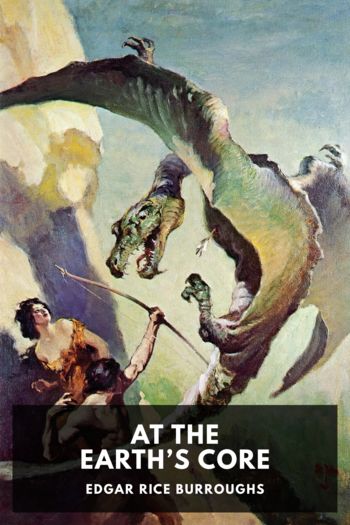At the Earth’s Core, Edgar Rice Burroughs [ink book reader .txt] 📗

- Author: Edgar Rice Burroughs
Book online «At the Earth’s Core, Edgar Rice Burroughs [ink book reader .txt] 📗». Author Edgar Rice Burroughs
“But the sun, Perry!” I urged. “How in the world can the sun shine through five hundred miles of solid crust?”
“It is not the sun of the outer world that we see here. It is another sun—an entirely different sun—that casts its eternal noonday effulgence upon the face of the inner world. Look at it now, David—if you can see it from the doorway of this hut—and you will see that it is still in the exact center of the heavens. We have been here for many hours—yet it is still noon.
“And withal it is very simple, David. The earth was once a nebulous mass. It cooled, and as it cooled it shrank. At length a thin crust of solid matter formed upon its outer surface—a sort of shell; but within it was partially molten matter and highly expanded gases. As it continued to cool, what happened? Centrifugal force hurled the particles of the nebulous center toward the crust as rapidly as they approached a solid state. You have seen the same principle practically applied in the modern cream separator. Presently there was only a small super-heated core of gaseous matter remaining within a huge vacant interior left by the contraction of the cooling gases. The equal attraction of the solid crust from all directions maintained this luminous core in the exact center of the hollow globe. What remains of it is the sun you saw today—a relatively tiny thing at the exact center of the earth. Equally to every part of this inner world it diffuses its perpetual noonday light and torrid heat.
“This inner world must have cooled sufficiently to support animal life long ages after life appeared upon the outer crust, but that the same agencies were at work here is evident from the similar forms of both animal and vegetable creation which we have already seen. Take the great beast which attacked us, for example. Unquestionably a counterpart of the Megatherium of the post-Pliocene period of the outer crust, whose fossilized skeleton has been found in South America.”
“But the grotesque inhabitants of this forest?” I urged. “Surely they have no counterpart in the earth’s history.”
“Who can tell?” he rejoined. “They may constitute the link between ape and man, all traces of which have been swallowed by the countless convulsions which have racked the outer crust, or they may be merely the result of evolution along slightly different lines—either is quite possible.”
Further speculation was interrupted by the appearance of several of our captors before the entrance of the hut. Two of them entered and dragged us forth. The perilous pathways and the surrounding trees were filled with the black ape-men, their females, and their young. There was not an ornament, a weapon, or a garment among the lot.
“Quite low in the scale of creation,” commented Perry.
“Quite high enough to play the deuce with us, though,” I replied. “Now what do you suppose they intend doing with us?”
We were not long in learning. As on the occasion of our trip to the village we were seized by a couple of the powerful creatures and whirled away through the tree tops, while about us and in our wake raced a chattering, jabbering, grinning horde of sleek, black ape-things.
Twice my bearers missed their footing, and my heart ceased beating as we plunged toward instant death among the tangled deadwood beneath. But on both occasions those lithe, powerful tails reached out and found sustaining branches, nor did either of the creatures loosen their grasp upon me. In fact, it seemed that the incidents were of no greater moment to them than would be the stubbing of one’s toe at a street crossing in the outer world—they but laughed uproariously and sped on with me.
For some time they continued through the forest—how long I could not guess for I was learning, what was later borne very forcefully to my mind, that time ceases to be a factor the moment means for measuring it cease to exist. Our watches were gone, and we were living beneath a stationary sun. Already I was puzzled to compute the period of time which had elapsed since we broke through the crust of the inner world. It might be hours, or it might be days—who in the world could tell where it was always noon! By the sun, no time had elapsed—but my judgment told me that we must have been several hours in this strange world.
Presently the forest terminated, and we came out upon a level plain. A short distance before us rose a few low, rocky hills. Toward these our captors urged us, and after a short time led us through a narrow pass into a tiny, circular valley. Here they got down to work, and we were soon convinced that if we were not to die to make a Roman holiday, we were to die for some other purpose. The attitude of our captors altered immediately as they entered the natural arena within the rocky hills. Their laughter ceased. Grim ferocity marked their bestial faces—bared fangs menaced us.
We were placed in the center of the amphitheater—the thousand creatures forming a great ring about us. Then a wolf-dog was brought—Hyaenodon Perry called it—and turned loose with us inside the circle. The thing’s body was as large as that of a full-grown mastiff, its legs were short and powerful, and its jaws broad and strong. Dark, shaggy hair covered its back and sides, while its breast and belly were quite white. As it slunk toward us it presented a





Comments (0)